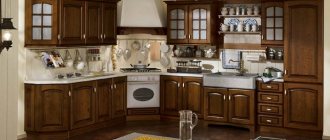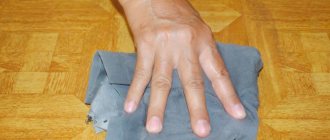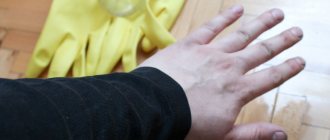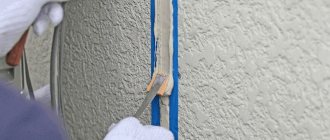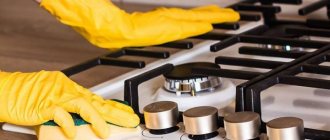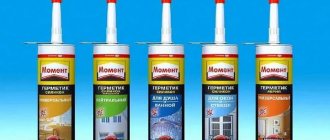The concept of cuisine came to us from the Germans in the era of Peter I. Previously in Rus' it was called a concoction or a cook. Modern kitchens can occupy a separate room or be combined with a dining room.
In the kitchen, food is prepared and food is stored. It is usually equipped with a sink, cutting tables, a stove, an oven, a microwave oven, cabinets for storing kitchen utensils, a refrigerator for preserving prepared dishes and storing raw food.
Many people in modern kitchens install dishwashers for washing dishes, under the wall cabinet above the range hoods, the purpose of which is to clean the air from combustion products, unpleasant odors, and fumes. But no matter how hard we try, cooking is always associated with contaminants that settle on kitchen furniture, walls, ceilings, forming grease deposits, and when using gas stoves, burning.
Recommendations before you start cleaning the kitchen
Before you start cleaning it, you need to find out what materials the kitchen furniture is made from. Wooden kitchens come unpainted and coated with a layer of paint, with plastic facades made of MDF and chipboard, varnished or laminated. But no matter what material is used to prepare kitchen furniture, before you start cleaning it, you should test the detergent to see if it reacts with the surface of the furniture somewhere in an inconspicuous corner. A small-sized surface treated with a cleaning agent is first allowed to dry, then the extent to which its color, shine, and general appearance has changed is determined.
During cooking, fat evaporates along with tiny droplets of water, which deposits a coating on the walls, ceiling, furniture, and other kitchen surfaces. If it is not removed in time, it is absorbed deeper into all surfaces and becomes old. To wash away grease deposits, you need to make a lot of effort. Therefore, general cleaning of all kitchen surfaces must be carried out at least once a year, and preferably twice.
Household chemicals
Kitchen cleaning products from the mass market can make cleaning, washing furniture and the entire kitchen as a whole much easier. But not every one of them is suitable for a particular coating, and the quality indicators are not always the best.
What to pay attention to when choosing and purchasing:
- functionality;
- compatibility with the material of facades, walls and countertops;
- compound;
- reviews from real customers;
- manufacturer's reputation.
Important! Ready-made cleaning solutions may contain abrasive solid particles - you must carefully study the contents and labels on the bottle or packaging.
Cleaning kitchen surfaces with different coatings
Kitchen furniture made from natural wood requires special delicacy. For cleaning, you cannot use household chemicals, which are based on alkali, which copes well with grease and other contaminants, but corrodes wood. Folk remedies containing peroxide, ammonia, and citric acid are also not suitable for cleansing it.
For kitchens made of natural wood, special products with a neutral pH are more suitable. A soap solution and liquids intended for caring for dishes, diluted with water in a ratio of 1 to 20, wash off grease and dirt well from wooden surfaces. To apply the composition to the surface, it is most convenient to use a spray bottle. In order not to harm the wood, movements should be directed along the grain.
Before applying cleaning products, the surface is moistened with plain water using the same spray bottle. This speeds up the reaction and makes cleansing easier. If you decide to moisten with a cloth, you must wring it out well so that excess moisture does not harm the wooden surfaces. Having finished cleaning, all surfaces must be treated with polish, a protective layer of oil or wax.
Steam cleaner
A very convenient tool that will help you get rid of even the oldest and most voluminous stains. The temperature of the water vapor is 100°C, due to which the fat will dissolve with greater efficiency than when washing with any liquids at room temperature. It is necessary to take into account the resistance of facades to steam - for example, a glossy film surface cannot be cleaned in this way.
Advice! It is not necessary to buy a steam cleaner specifically for cleaning the kitchen - a steam generator for clothes is also great for similar purposes.
Soda-oil mixture for wooden surfaces
For wooden kitchens with unpainted surfaces, but coated with various impregnations such as varnish, oil, wax, a mixture of vegetable oil (1 tablespoon) with soda (1.5 tablespoons) is suitable. The resulting mixture is applied in an even layer to the contaminated surface. Be prepared for the fact that some of the soda will crumble, but the oil, absorbed into the wood, literally immediately makes it cleaner, adding a little brightness. All that remains is to remove the remaining soda with a soft, slightly moistened cloth.
It is recommended to clean kitchen furniture at least once every 60 days. The unpleasant aspect of the soda-oil solution is that the light surface of kitchens can acquire a yellowish tint. The positive side is that the mixture not only copes with old stains of grease and soot deposits, but also protects the wooden surface from dirt and water absorption, clogging its pores.
Unusual cleaning products
In order to remove the most unpleasant stains from the table, you can use various cleaning sprays, gels and powders. But despite the wide range of detergent compositions, there are several unusual options for removing contaminants:
- Powdered mustard. You should rub it into the surface of the wooden table. This way the color will be refreshed and stubborn dirt will be washed away. Remains of mustard powder are removed with a dry sponge.
- Lemon. Has good disinfection properties. The surface of the table is treated with a circle of fruit. All stains will immediately lighten after use.
- Vodka. It works on the same principle as medical alcohol. Removes “colorful” stains and kills germs.
Important! When purchasing a chemical cleaning composition, pay attention to the instructions. It is not recommended to purchase abrasive substances, as they can adversely affect the structure of the furniture.
Removing grease stains and dirt with vinegar solution
A solution of warm water and vinegar in equal proportions is suitable for any surface except natural wood. Warm vinegar water can be applied to the contaminated surface with a sponge or spray bottle. After cleaning the surface from dirt, wipe it with a dampened, then dry soft cloth. You should not clean kitchen furniture more often than once a quarter.
Cleaning using traditional methods
After purchasing a kitchen countertop, it is recommended to follow the care instructions and use it for its intended purpose. Proper compliance with operational standards affects the long-term service life of kitchen furniture.
Remember the following basics of proper care:
- The tabletop is not intended for cutting food, as this can have a detrimental effect on its surface - leaving scratches.
- Laminated kitchen tables are not resistant to high temperatures and water. It is not recommended to place hot dishes on them without a stand. If you notice a watery stain, try to remove it as quickly as possible with a dry cloth.
Vinegar with isopropyl alcohol for deep cleaning
A solution of 6 percent vinegar with isopropyl alcohol helps to cope with difficult stains on painted and unpainted wooden surfaces. It is also suitable for removing old grease stains, dirt and grime from worktops, plastic facades of fibreboard and chipboard, varnished surfaces, cladding films and tiles.
To prepare the solution, take 7 parts of 6 percent vinegar and 1 part of isopropyl alcohol, which can be purchased at stores selling consumables for office equipment, and a couple of drops of liquid detergent. Using a napkin soaked in the solution, wipe all contaminated areas of the furniture. The mixture is then removed with warm water, and the surface of the cabinets is rubbed with polish or, in the case of wood, wax. This, for some time, will protect the surface of the kitchen furniture from repeated contamination and moisture penetration.
Melamine sponge
This method is suitable for washing any coating, but copes with minor stains. It is advisable to additionally moisten the sponge with vinegar - this will enhance the effect and rid the furniture of greasy stains much faster than washing with plain water. After using vinegar, rinse the surfaces with plain water.
Note!
Choosing a carpet for the kitchen floor
Melamine sponge - how to use correctly? All the pros and cons of the miracle sponge
How to descale a kettle: vinegar, citric acid, soda, brine, soda. TOP most effective cleaning methods!
Ammonia
A good product for cleaning kitchen surfaces is ammonia, diluted with warm water in proportions of 1 to 1. You just need to use it with caution, no more than once a quarter, and do not apply it to wooden furniture. The liquid is applied to the surface using a spray bottle or foam sponge. Then a cloth moistened with water comes into play. The final stage is wiping with a dry cloth.
Chipboard
Chipboard countertops are a popular choice for kitchens. Such surfaces are covered with special heat-resistant, wear-resistant and environmentally friendly plastic.
The matte surface of this tabletop is more scratch resistant. However, with proper care, scratches will not appear for a long time on glossy surfaces.
The most important thing in caring for chipboard countertops is to minimize the interaction of any liquid with the surface, since the material tends to absorb moisture, swell and collapse.
- To remove more difficult stains, such as oil stains, you can use liquid dishwashing detergent.
- You can remove stubborn stains from the light-colored surface of a chipboard countertop using baking soda diluted with water to a thick paste.
- Stubborn stains are removed from dark-colored surfaces using a 5% vinegar solution or lemon juice.
Important! Use a damp cloth first and then a dry one to remove stains. Don't forget about cutting boards and stands for hot pans and pots. The use of washing powders for cleaning and washing the surface is not recommended.
Hydrogen peroxide with water
Hydrogen peroxide is used in the form of an aqueous solution, 1 part peroxide to 2 parts water. This mixture is intended for MDF and chipboard boards. For wooden surfaces it is used only to remove mold. The product not only effectively fights grease and other contaminants, but also helps disinfect surfaces. You can treat contaminated areas with a spray bottle or using a soft rag as they become dirty.
How and with what to clean the countertop in the kitchen?
Ammonia is good at cleaning plastic, furniture and aluminum pots and utensils, stoves, microwaves and other appliances, and kitchen utensils from stubborn deposits and grease.
- Dilute 1 tbsp. l. ammonia in 1 liter. water.
- Soak the sponge in the resulting liquid.
- Treat the surface.
- After 5-10 minutes, wash off the dirt with a clean cloth.
Be aware of the strong ammonia smell. Before preparing the solution, be sure to provide a flow of fresh air into the room.
To quickly remove grease from a bright kitchen, mix peroxide with baking soda to enhance the effect (if the surface is not varnished):
- Prepare a creamy mixture of baking soda and hydrogen.
- Treat the surface.
- Allow the solution to soak for 20–30 minutes.
- Scrub with a brush and wash off the acidified fat with a sponge.
Wash surfaces that deteriorate from contact with abrasive substances with hydrogen peroxide, combining it with detergent, or using it as an independent product.
Note! If during the process of washing the kitchen a white towel or apron or tulle becomes dirty, place them in a pan with boiling water and 2 tbsp. l. peroxide, boil for about 10 minutes. The product will remove darkening at the bottom of the pan itself and whiten the towel and yellowed tulle.



